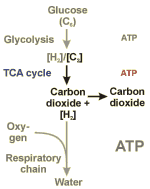 Tricarboxylic acid (TCA) cycle
Tricarboxylic acid (TCA) cycle
Central metabolic pathway for the oxidation of activated acetic acid residues ([C2]) to carbon dioxide.
Activated acetic acid residues are formed by the degradation of various compounds (e.g. from glucose via glycolysis). Oxidation of these residues leads to the formation of carbon dioxide and reduction equivalents ([H2]), which are further oxidized by the respiratory chain. Corresponding to its important role in energy production, the tricarboxylic acid cycle (like the respiratory chain) is located in the "power stations" of the cell, the mitochondria.